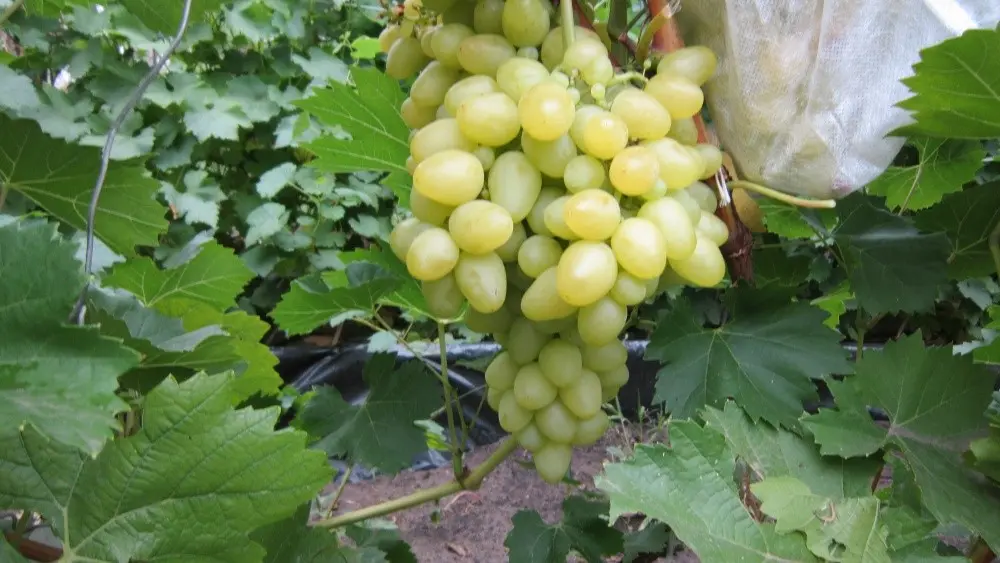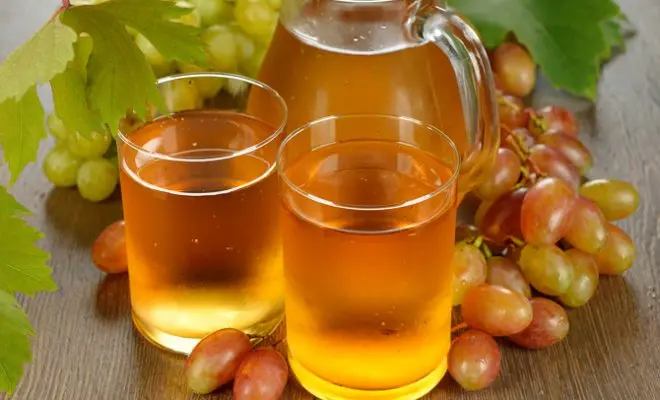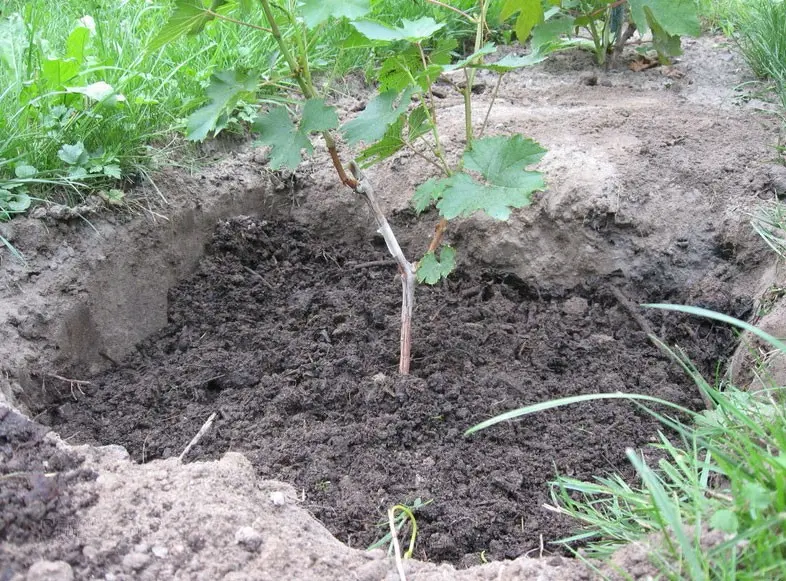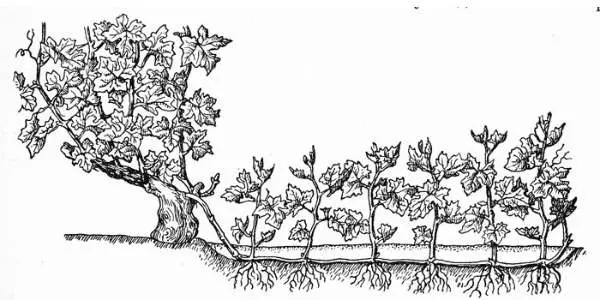Contents
Super Extra grapes have earned the respect of winegrowers due to the rapid ripening period and high resistance to frost. This early ripe variety can be grown in the south, in the middle lane, and in the north. It is suitable for both beginners and experienced gardeners.
History of breeding varieties
Super Extra was bred in Novocherkassk as a result of selection of two varieties – Cardinal and Talisman. Amateur vine grower Yevgeny Pavlovsky crossed the pollen of these species.

Cardinal has a nutmeg flavor and large clusters, and Talisman – high resistance to low temperatures. Thus, the hybrid combined these properties and became one of the best early ripening table varieties.
Botanical portrait of culture
Super Extra grapes are tall bushes with light berries. A ripe bunch glows in the sun, which increases the presentation of the berries.
Description of the bush and vine
Bushes after planting grow very quickly and reach a height of 1,5–3 m. Young shoots are light green. In the process of aging, they become stiff and acquire a brown tint. The leaves are large, the same shape, bright green.
Description of grapes and berries
The clusters of this variety are very large, their average weight is 700–900 g. With good care, champions can reach a mass of 1,5–1,7 kg. The shape of the bunch is triangular, branched, loose.

The berries are large, weighing from 10 to 12 g. The shape is oval, slightly pointed at the bottom. Color – from light yellow at the beginning of ripening to amber at the end. The skin is thick but edible. The pulp of a ripe berry is fleshy, juicy, very sweet. For those who prefer a sweet and sour taste, growers recommend picking the bunches a week before they are fully ripe, when they contain a small amount of acid.
Video «Features of Super Extra grapes»
From this video you will learn about the intricacies of growing a hybrid.
Main characteristics
The early table variety Super Extra is used in winemaking and juice production due to its high productivity.
Pollination, ripening and fruiting
This grape variety belongs to the category of ultra-early.
The ripening period is from 85 to 100 days. In the south, it begins to ripen in the first decade of July, in the northernmost regions – in early August.
Abundant fruiting begins 10–14 days after the onset of ripening. It lasts about two weeks. After harvesting the first crop, stepchild clusters are formed. They are much smaller, but sweeter and better pollinated.
Productivity and use of fruits
The yield of the variety is very high. With proper care, you can collect from 10 to 14 kg from one bush. Juice can be squeezed out of berries, which will be stored for a long time due to protective substances. If it turns out too sweet, it can be diluted with sour apple juice. This will balance the taste of the finished product and give new facets of taste.

Thanks to the pronounced muscat flavor, the grapes make an excellent white wine. It can be made entirely from the Super Extra variety or mixed with other varieties. The most interesting combinations are obtained by adding a small amount of dark grapes. This will make the taste of the wine more complex and interesting and give it a nice pinkish color.
Drought and frost resistance
This variety is cold tolerant. –25°C. In summer, it can produce a high yield at low temperatures of + 12 … + 15 ° C. This allows it to be grown in northern regions with short summers and extremely cold winters, where even unpretentious grape varieties rarely take root.
In the south, where winter temperatures rarely drop below 0°C, growers do without abundant shrub cover. In summer, it ripens already in early July and even manages to give a second harvest. Moreover, it is resistant to drought, which is common in southern regions.
This grape does not require watering more than once every 7–10 days. In cool and cloudy weather, it can be left without watering for up to two weeks.
Author’s advice
Advantages and disadvantages of the variety
Pros:
- frost resistance up to –25 °C;
- high yield – up to 14 kg per bush;
- early ripening;
- large sizes of berries and clusters;
- pleasant taste and versatility of application;
- low susceptibility to diseases and pests;
- thick skin for easy transport.
Cons:
- intolerance to bush overload and the need for constant removal of ripe clusters;
- different sizes of berries;
- increased attractiveness of the variety for wasps;
- weak resistance against aphids phylloxera.
Characteristic features of cultivation
The hybrid does not require special growing conditions. To grow healthy shrubs, you need to correctly calculate the time of planting and pruning and apply the necessary fertilizers.
Landing algorithm
Grapes are planted in spring or autumn. Spring planting is best practiced in the north so that young, fragile seedlings do not have to endure a frosty winter. In the south, they can be planted in October-November.

Before planting, the seedling must be placed in water for 36–48 hours. At this time, it is necessary to prepare the correct hole. Its dimensions should be 80x80x80 cm. At its bottom, it is necessary to pour a 10-centimeter layer of fertile soil rich in useful substances, 8–10 kg of manure, nitroammophoska and ash. From above, the soil is again filled up. This stock of fertilizers will be enough for a bush for several years.
The seedling is planted at a height of 35–40 cm from the ground. It is covered with earth dug from a hole. A hole 10 deep is left on the surface–15 cm for watering. Immediately after planting, the bush is watered abundantly 3–4 buckets of water.
Watering and top dressing
Immediately after planting, the grapes are watered at least once a week. When the plant takes root, it can be irrigated no more than 2–3 times a month. Under each bush pour 20–30 liters of water. Humidification is carried out gradually so that the liquid has time to be absorbed. In August, watering is stopped so that the vine is formed.
In the spring, the bushes are fertilized with manure, bird droppings, compost, nitroammophos. In autumn, mineral fertilizers can be applied: nitrogen, phosphorus, potassium.
Pruning the vine and shaping the bush
Experienced gardeners advise pruning in the fall, when the movement of juices slows down. It also makes it easier to cover the bushes for the winter.

A few weeks after the end of fruiting, you can begin to form a bush. The thicker the shoot, the more eyes on it must be left. Since the clusters of this variety are voluminous, their number corresponds to the size of the vine in diameter. For example, on a shoot 5 mm thick, 5 eyes are left, on a 12 mm branch – 12. Having calculated the required number of buds, it is necessary to cut the vine at the level of living wood with a sharp pruner. The cut must be light green.
After pruning, the grapes are watered abundantly and left alone for 1–2 weeks. After that, it can be covered for the winter.
Features of reproduction
The easiest way to breed – ground escape powder. To do this, in spring or early summer, a strong healthy vine is chosen and at a distance of 30–40 cm from the bush dig a small depression in the ground.

The branch is gently tilted to the ground and sprinkled with soil. In autumn, when new bushes are formed, they are separated from each other, and in the spring of next year they are planted as full-fledged seedlings.
Diseases and pests
The hybrid variety Super Extra is highly resistant to diseases and parasites. The weakest point of this plant is the phylloxera aphid. When affected by this pest, yellowish blistering bulges appear on the leaves. Insects are spread by the wind, on clothes and gardening tools. The infected plant begins to turn yellow, wither, weakly bears fruit.
Phylloxerra can only be controlled by mechanical removal of the affected parts. They are isolated from healthy plants and must be burned. If you do not notice the appearance of aphids in time, it may be necessary to completely destroy the bush in order to save the entire vineyard.
Reviews of growers
Amateur gardeners and experienced growers leave high reviews for the hybrid variety.
«My husband and I wanted to grow grapes, and could not find a variety that would fit our cold climate. Even if it bore fruit in the summer, it froze over the winter. Then we bought several seedlings of Super Extra, Super Lala and Prairie Star. The first one showed itself best of all: it does not freeze, does not get sick, bears fruit abundantly. In the spring we are going to expand our farm». «Every year I make grape wine for myself and my family. It is expensive to buy berries, and it is more pleasant to grow them yourself. It’s just that I’ve never done it. The market was advised to take Super Extra. I do not regret, because this variety – the best for beginners. It rarely gets sick, does not require careful care, and tolerates winter well. Yes, the wine is rich and delicious.». «We grow grapes for sale. Super Extra, of course, pleased me with the fact that it does not freeze and ripens early. At the beginning of July, when the grapes are still rare on the market, I already go out with large ripe bunches. But the berries in them are of different sizes, heterogeneous, so the price has to be slightly reduced. It’s a little disappointing».
Super Extra – prolific and resistant to diseases, pests and frost. With proper care, he gives at least 10 kg per bush. Due to its expressive taste, it is widely used in winemaking.









